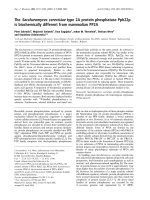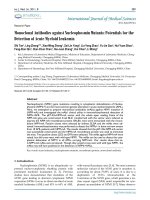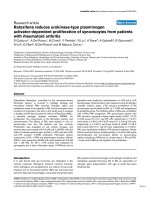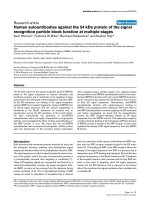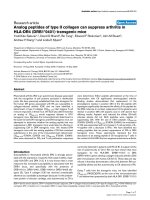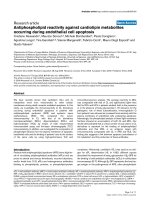Báo cáo y học: "Rare protection against type 1 diabete" potx
Bạn đang xem bản rút gọn của tài liệu. Xem và tải ngay bản đầy đủ của tài liệu tại đây (52.96 KB, 3 trang )
Genome
BBiioollooggyy
2009,
1100::
219
Minireview
RRaarree pprrootteeccttiioonn aaggaaiinnsstt ttyyppee 11 ddiiaabbeetteess
Robert M Plenge
Address: Division of Rheumatology, Immunology and Allergy, Brigham and Women’s Hospital, 77 Avenue Louis Pasteur, Boston, MA 02115,
USA. Email:
AAbbssttrraacctt
A large population study using ultra-high-throughput DNA sequencing to re-sequence a genetic
locus associated with type 1 diabetes reveals rare protective alleles.
Published: 15 May 2009
Genome
BBiioollooggyy
2009,
1100::
219 (doi:10.1186/gb-2009-10-5-219)
The electronic version of this article is the complete one and can be
found online at />© 2009 BioMed Central Ltd
Unlike inherited Mendelian diseases such as cystic fibrosis,
the common complex diseases such as diabetes and heart
disease have no single predisposing genetic factor. But, over
the years, alleles at various genetic loci that either decrease
or increase the risk of developing such diseases, in relation
to their incidence in the general population, have been
uncovered. Geneticists have made the somewhat artificial
distinction between ‘common’ and ‘rare’ when describing
alleles at polymorphic genetic loci. Classically, ‘common’
variants are those occurring at a frequency of more than 1%
in any one continental population (for example, Europeans,
Asians or Africans), whereas ‘rare’ variants are present at a
frequency of less than 1%.
This distinction is used to frame the genetic approach to
discovering and testing DNA variants and linking them to
disease. For common variants, it is possible to screen a
reference population to identify a catalog of variants
(discovery phase), and then test these variants in collections
of cases and matched controls (case-control studies) using
high-throughput genotyping technologies (testing phase).
For rare variants, both the discovery and testing phases can
only be done in case-control collections themselves. In a
recent paper in Science, Nejentsev et al. [1] describe the use
of next-generation DNA sequencing of a large case-control
population to search for, and find, rare protective alleles at a
locus associated with susceptibility to type 1 diabetes, the
gene IFIH1 (interferon induced with helicase C domain 1).
A variety of resources have been developed to test the role of
common single nucleotide polymorphisms (SNPs) in
common human diseases such as type 1 diabetes. Most
notably, the International Haplotype Map (HapMap) Project
has generated a catalog of more than 3 million variants in
three continental populations (Europeans, Asians and
Africans) [2,3]. On the basis of the number of individuals
genotyped (n = 90 in each continental population), the
HapMap Project was calibrated to study DNA variants of
greater than 5% frequency. Phase III of HapMap, which is
nearly complete, will push the allele-frequency spectrum to
1% (by genotyping more individuals), and extend the project
to other continental populations (by genotyping individuals
of different ancestries). High-throughput genotyping tech-
nologies [4] and statistical methods [5,6] have been developed
to test common variants from the HapMap in large
collections of patients and controls. A number of successes
have emerged, including the identification of more than ten
loci associated with type 1 diabetes [7].
Because of these evolving resources, a more accurate
description of the allele-frequency spectrum is to classify
DNA variants as those that are truly common (greater than
5% frequency), those that are truly rare (for example, private
to a few families and of very recent mutational origin), and
those that are low frequency (greater than 0.1% but less than
5%). Low-frequency variants are of recent mutational origin,
but nonetheless segregate on a single ancestral haplotype
and are amenable to testing with high-throughput geno-
typing technology - if they have been cataloged in a reference
population. The number of low-frequency alleles available in
reference populations such as HapMap depends upon the
size of the reference population: the more subjects geno-
typed for known polymorphims, the larger the number of
low-frequency variants that can be cataloged. The vast
majority of common SNPs have been discovered and
deposited in the dbSNP database, and the majority of these
have either been genotyped directly or adequately tagged by
a SNP in HapMap. However, many low-frequency variants,
and most rare variants, are not available in dbSNP and
therefore cannot be tested in genome-wide association
studies (GWAs). Thus, re-sequencing is required to discover
and test low-frequency and rare variants.
NNeexxtt ggeenneerraattiioonn rree sseeqquueenncciinngg
Conventional Sanger sequencing technology still accounts
for the overwhelming majority of DNA sequencing. How-
ever, cost constraints and throughput capacity limit its use
in medical genetics. More recently, new sequencing systems
based on massively parallel sequencing of short fragments
by techniques such as pyrosequencing have been developed,
which are poised to reduce DNA sequencing costs and raise
capacity by several orders of magnitude. Often called next-
generation sequencing, this technology is expected to
mature rapidly over the next few years, prompting hope of
the ‘$1,000 genome’. If successful, these sequencing
advances will enable GWAs of common, rare and low-
frequency variants.
To harness the full power of next-generation sequencing for
testing the complete spectrum of alleles in human diseases,
at least three challenges must be addressed. The first is to
capture the target of interest; the second is to identify DNA
variants from sequence data; and the third is to test the DNA
variants for their role in disease. These three issues are now
major bottlenecks in the widespread application of next-
generation sequencing in medical genetics and I shall
discuss the recent study of Nejentsev et al. [1] with those
points in mind. Despite success in identifying two new
protective alleles, their work illustrates well the limitations
imposed by the three challenges.
PPrrootteeccttiivvee llooww ffrreeqquueennccyy vvaarriiaannttss iinn
IIFFIIHH11
Nejentsev et al. [1] ask a simple question, which they answer
quite convincingly by re-sequencing using the Roche/454
instrument: do low-frequency or private rare mutations
predispose to common forms of type 1 diabetes? To address
this, they sequenced the coding exons of ten genes with prior
evidence of importance in type 1 diabetes; six of these genes
harbor common SNPs that influence the risk of the disease
(PTPN22, PTPN2, IFIH1, SH2B3, CLEC16A, and IL2RA).
The authors capture 31 kb of target sequence using PCR-
directed amplification of DNA pooled from either 10 cases or
10 controls and eventually identify 212 SNPs in this region
(many important details on the sequencing and SNP calling
are included in the Supplementary methods to [1]). This
represents an average of 1 SNP per approximately 150 bp.
From the pooled sequencing data, Nejentsev et al. [1]
estimate that 33 SNPs have frequencies greater than 3%, and
that 179 have frequencies less than 3%; of these 179, 156
were previously unknown.
In an association study using allele-frequency estimates, the
authors then identify two low-frequency SNPs in the IFIH1
gene that confer protection from type 1 diabetes. The SNP
with the strongest association, rs35667974, was observed on
an estimated 3 out of 960 case chromosomes, but 24 out of
960 control chromosomes (P = 0.00004); another SNP,
rs35337543, was observed on 7 case chromosomes and 23
control chromosomes (P = 0.005). Both SNPs were geno-
typed in an additional 8,379 type 1 diabetes patients and
10,575 controls from Britain, and 3,165 families from Europe
and the United States comprising one or more offspring with
type 1 diabetes and their parents. In this extended genetic
association study, rs35667974 was present at a frequency of
around 1% among cases and 2% among controls (combined
P = 2.1 × 10
-16
). This SNP resides in exon 14 and changes a
conserved isoleucine at position 923 to valine. The other
SNP, rs35337543, has a frequency of 1% versus 1.5% among
cases and controls, respectively, and has a combined P-value
of 1.4 × 10
-4
. It resides within a conserved splice donor site
at position +1 in intron 8 of IFIH1.
RReemmaaiinniinngg cchhaalllleennggeess
Several important details in the study of Nejentsev et al. [1]
pertain to the three issues noted earlier: target capture; SNP
calling from sequence data; and the statistical approach with
which they test for association. To capture the coding exons
of these ten genes, they used a PCR-based method, which is
laborious and expensive. In the current study, 144 separate
PCR fragments were required. It would be very difficult to
scale this method to larger portions of the genome (for
example, all coding exons). Other target-capture approaches
also have limitations, including a lack of specificity of
enrichment for the region of interest and the uniformity with
which targets are captured [8,9].
The current study called SNPs and estimated allele
frequency directly from the sequencing data. This was done
from pools of ten individuals, without barcode identifiers. It
is not clear how accurate this method will be. The study
reports a strong correlation (r
2
= 0.99) between allele-
frequency estimates from sequencing and genotyping data.
However, these data are from only eight SNPs in twenty
pooled DNA samples. Closer inspection of Supplementary
Figure 1 of [1] shows that some of the pools have very
different allele-frequency estimates, which raises questions
about the accuracy of allele-frequency estimates from pooled
sequencing data.
Finally, the association study design mimics that used for
common SNPs: each individual SNP is tested for association
in cases and controls separately, without regard to putative
function and gene context. A more powerful approach,
especially for truly private rare variants, might be to test
whether any gene (or prespecified gene set) has an excess
number of rare variants in either cases or controls [10].
/>Genome
BBiioollooggyy
2009, Volume 10, Issue 5, Article 219 Plenge 219.2
Genome
BBiioollooggyy
2009,
1100::
219
This study shows that low-frequency variants can influence
the risk of type 1 diabetes. Both rs35667974 and rs35337543
would be classified as low frequency rather than rare, private
mutations, but even so re-sequencing was necessary to
discover and test both of them. There are ongoing studies to
expand SNP discovery and genotyping in reference
populations (for example [11]). These resources should
enable large-scale genetic association studies of putative
functional SNPs such as rs35667974 and rs35337543.
However, re-sequencing will be required to test the full
spectrum of alleles, from truly common to truly rare. And, as
demonstrated by Nejentsev et al. [1], next-generation re-
sequencing represents a powerful tool.
RReeffeerreenncceess
1. Nejentsev S, Walker N, Riches D, Egholm M, Todd JA:
RRaarree vvaarriiaannttss
ooff
IIFFIIHH11
,, aa ggeennee iimmpplliiccaatteedd iinn aannttiivviirraall rreessppoonnsseess,, pprrootteecctt aaggaaiinnsstt ttyyppee
11 ddiiaabbeetteess
Science
2009,
332244::
387-389.
2. International HapMap Consortium, Frazer KA, Ballinger DG, Cox
DR, Hinds DA, Stuve LL, Gibbs RA, Belmont JW, Boudreau A, Hard-
enbol P, Leal SM, Pasternak S, Wheeler DA, Willis TD, Yu F, Yang H,
Zeng C, Gao Y, Hu H, Hu W, Li C, Lin W, Liu S, Pan H, Tang X,
Wang J, Wang W, Yu J, Zhang B, Zhang Q, Zhao H,
et al
.:
AA sseeccoonndd
ggeenneerraattiioonn hhuummaann hhaapplloottyyppee mmaapp ooff oovveerr 33 11 mmiilllliioonn SSNNPPss
Nature
2007,
444499::
851-861.
3. Consortium TIHM:
AA hhaapplloottyyppee mmaapp ooff tthhee hhuummaann ggeennoommee
Nature
2005,
443377::
1299-1320.
4. Wang DG, Fan JB, Siao CJ, Berno A, Young P, Sapolsky R, Ghandour
G, Perkins N, Winchester E, Spencer J, Kruglyak L, Stein L, Hsie L,
Topaloglou T, Hubbell E, Robinson E, Mittmann M, Morris MS, Shen
N, Kilburn D, Rioux J, Nusbaum C, Rozen S, Hudson TJ, Lipshutz R,
Chee M, Lander ES:
LLaarrggee ssccaallee iiddeennttiiffiiccaattiioonn,, mmaappppiinngg,, aanndd ggeennoottyypp
iinngg ooff ssiinnggllee nnuucclleeoottiiddee ppoollyymmoorrpphhiissmmss iinn tthhee hhuummaann ggeennoommee
Science
1998,
228800::
1077-1082.
5. Purcell S, Neale B, Todd-Brown K, Thomas L, Ferreira MA, Bender
D, Maller J, Sklar P, de Bakker PI, Daly MJ, Sham PC:
PPLLIINNKK:: aa ttooooll
sseett ffoorr wwhhoollee ggeennoommee aassssoocciiaattiioonn aanndd ppooppuullaattiioonn bbaasseedd lliinnkkaaggee
aannaallyysseess
Am J Hum Genet
2007,
8811::
559-575.
6. Price AL, Patterson NJ, Plenge RM, Weinblatt ME, Shadick NA, Reich
D:
PPrriinncciippaall ccoommppoonneennttss aannaallyyssiiss ccoorrrreeccttss ffoorr ssttrraattiiffiiccaattiioonn iinn
ggeennoommee wwiiddee aassssoocciiaattiioonn ssttuuddiieess
Nat Genet
2006,
3388::
904-909.
7. Altshuler D, Daly MJ, Lander ES:
GGeenneettiicc mmaappppiinngg iinn hhuummaann ddiisseeaassee
Science
2008,
332222::
881-888.
8. Porreca GJ, Zhang K, Li JB, Xie B, Austin D, Vassallo SL, LeProust
EM, Peck BJ, Emig CJ, Dahl F, Gao Y, Church GM, Shendure J:
MMuullttii
pplleexx aammpplliiffiiccaattiioonn ooff llaarrggee sseettss ooff hhuummaann eexxoonnss
Nat Methods
2007,
44::
931-936.
9. Gnirke A, Melnikov A, Maguire J, Rogov P, LeProust EM, Brockman
W, Fennell T, Giannoukos G, Fisher S, Russ C, Gabriel S, Jaffe DB,
Lander ES, Nusbaum C:
SSoolluuttiioonn hhyybbrriidd sseelleeccttiioonn wwiitthh uullttrraa lloonngg
oolliiggoonnuucclleeoottiiddeess ffoorr mmaassssiivveellyy ppaarraalllleell ttaarrggeetteedd sse
eqquueenncciinngg
Nat
Biotechnol
2009,
2277::
182-189.
10. Kryukov GV, Shpunt A, Stamatoyannopoulos JA, Sunyaev SR:
PPoowweerr
ooff ddeeeepp,, aallll eexxoonn rreesseeqquueenncciinngg ffoorr ddiissccoovveerryy ooff hhuummaann ttrraaiitt ggeenneess
Proc Natl Acad Sci USA
2009,
110066::
3871-3876.
11.
TThhee 11000000 GGeennoommeess PPrroojjeecctt
[]
/>Genome
BBiioollooggyy
2009, Volume 10, Issue 5, Article 219 Plenge 219.3
Genome
BBiioollooggyy
2009,
1100::
219


